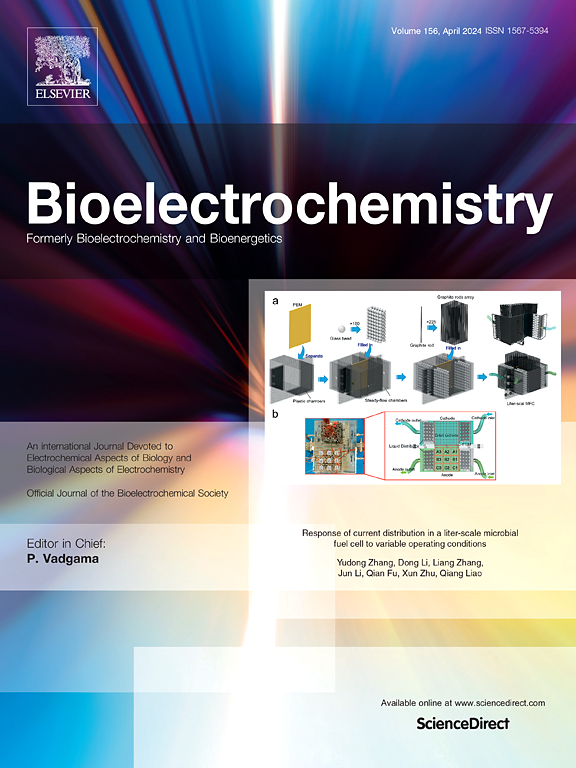Development of flexible regenerable lactate-specific molecularly imprinted polymers based on laser-induced graphene electrochemical biosensor
IF 4.5
2区 化学
Q1 BIOCHEMISTRY & MOLECULAR BIOLOGY
引用次数: 0
Abstract
Lactate is a key biomarker for assessing tissue hypoxia, sepsis, and metabolic disorders, making its accurate detection essential for clinical diagnostics, health monitoring, and sports performance evaluation. Here we present a molecularly imprinted polymer (MIP)-based electrochemical sensor using a laser-induced graphene (LIG) electrode modified with poly(3,4-ethylenedioxythiophene) (PEDOT) for selective and sensitive lactate detection. Sensor fabrication was optimized, including PEDOT deposition and MIP synthesis conditions, to enhance imprinting efficiency and lactate recognition. Characterization using scanning electron microscopy and energy-dispersive X-ray spectroscopy confirmed uniform deposition and effective surface modification. Incorporating cetyltrimethylammonium bromide to regenerate the sensor surface improved signal stability and minimized non-specific binding. The flexible sensor maintained stable performance under mechanical stress and exhibited good operational stability. Using square wave voltammetry, the LIG-MIP biosensor demonstrated a wide detection range of 0.1–1000 μM with a high sensitivity of 27.68 μA/log μM, and a low detection limit of 0.033 μM. Selectivity toward lactate was confirmed in the presence of potent interferents in lactate analysis. The stability and reproducibility were evaluated and validated in artificial saliva. This flexible, highly sensitive regenerable MIP-based sensor offers a promising platform for real-time lactate monitoring in biomedical and wearable applications.
基于激光诱导石墨烯电化学生物传感器的柔性可再生乳酸特异性分子印迹聚合物的研制
乳酸是评估组织缺氧、败血症和代谢紊乱的关键生物标志物,其准确检测对临床诊断、健康监测和运动表现评估至关重要。在这里,我们提出了一种基于分子印迹聚合物(MIP)的电化学传感器,该传感器使用用聚(3,4-乙烯二氧噻吩)(PEDOT)修饰的激光诱导石墨烯(LIG)电极,用于选择性和敏感的乳酸检测。优化了传感器的制作工艺,包括PEDOT沉积和MIP合成条件,以提高印迹效率和乳酸的识别能力。利用扫描电子显微镜和能量色散x射线光谱进行表征,证实了均匀沉积和有效的表面改性。结合十六烷基三甲基溴化铵再生传感器表面提高了信号稳定性和最小化非特异性结合。柔性传感器在机械应力下性能稳定,具有良好的工作稳定性。利用方波伏安法,该传感器具有0.1 ~ 1000 μM的宽检测范围和27.68 μA/log μM的高灵敏度,0.033 μM的低检测限。在乳酸分析中,对乳酸的选择性被证实存在强干扰。在人工唾液中评价和验证了该方法的稳定性和重复性。这种灵活、高灵敏度、可再生的基于mip的传感器为生物医学和可穿戴应用中的实时乳酸监测提供了一个有前途的平台。
本文章由计算机程序翻译,如有差异,请以英文原文为准。
求助全文
约1分钟内获得全文
求助全文
来源期刊

Bioelectrochemistry
生物-电化学
CiteScore
9.10
自引率
6.00%
发文量
238
审稿时长
38 days
期刊介绍:
An International Journal Devoted to Electrochemical Aspects of Biology and Biological Aspects of Electrochemistry
Bioelectrochemistry is an international journal devoted to electrochemical principles in biology and biological aspects of electrochemistry. It publishes experimental and theoretical papers dealing with the electrochemical aspects of:
• Electrified interfaces (electric double layers, adsorption, electron transfer, protein electrochemistry, basic principles of biosensors, biosensor interfaces and bio-nanosensor design and construction.
• Electric and magnetic field effects (field-dependent processes, field interactions with molecules, intramolecular field effects, sensory systems for electric and magnetic fields, molecular and cellular mechanisms)
• Bioenergetics and signal transduction (energy conversion, photosynthetic and visual membranes)
• Biomembranes and model membranes (thermodynamics and mechanics, membrane transport, electroporation, fusion and insertion)
• Electrochemical applications in medicine and biotechnology (drug delivery and gene transfer to cells and tissues, iontophoresis, skin electroporation, injury and repair).
• Organization and use of arrays in-vitro and in-vivo, including as part of feedback control.
• Electrochemical interrogation of biofilms as generated by microorganisms and tissue reaction associated with medical implants.
 求助内容:
求助内容: 应助结果提醒方式:
应助结果提醒方式:


